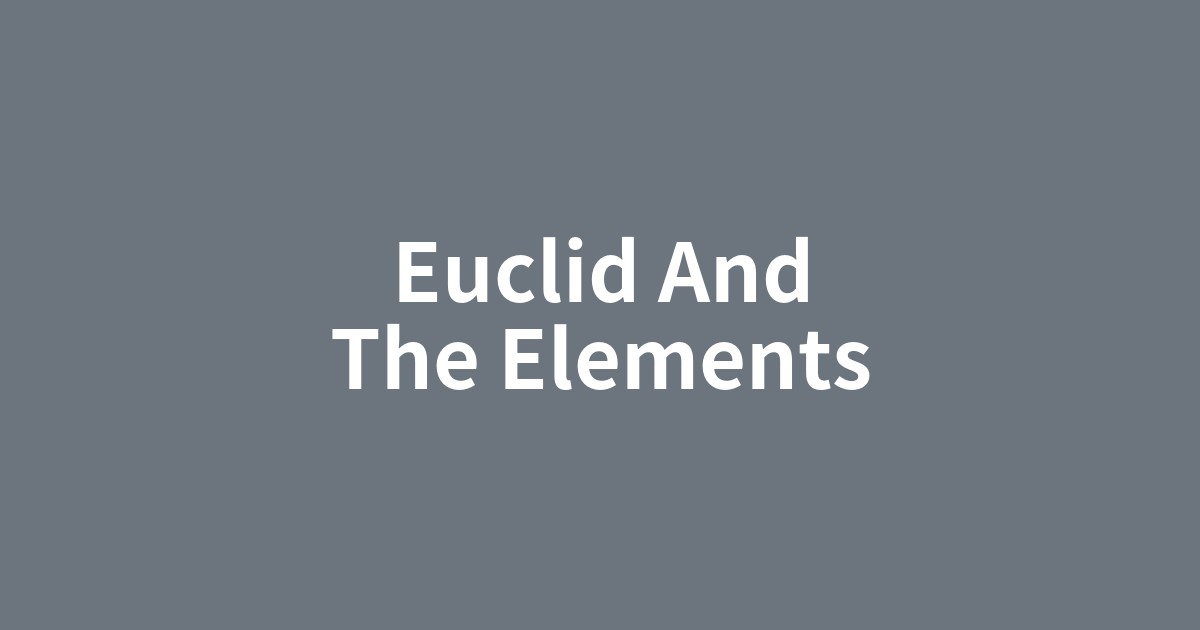このページは、歴史や文化の物語を楽しみながら、その文脈の中で重要な英単語を自然に学ぶための学習コンテンツです。各セクションの下にあるボタンで、いつでも日本語と英語を切り替えることができます。背景知識を日本語で学んだ後、英語の本文を読むことで、より深い理解と語彙力の向上を目指します。

たった5つの公準から、今日まで続く幾何学の体系を築き上げた『原論』。論理的思考のmasterpiece(傑作)として、2000年以上読み継がれる理由。
この記事で抑えるべきポイント
- ✓ユークリッド(Euclid)という人物の生涯は謎に包まれているものの、彼が編纂したとされる『原論』が西洋の知性史に与えた影響は計り知れないこと。
- ✓『原論』の革新性は、単なる知識の集積ではなく、少数の「公準(postulate)」と「公理(axiom)」から出発し、厳密な論理(logic)のみで定理を証明していく「公理的方法」を確立した点にあること。
- ✓5つの公準の中でも、特に「第5公準(平行線公準)」をめぐる議論が、近代数学における非ユークリッド幾何学の誕生へと繋がり、科学観の変革を促したこと。
- ✓『原論』が示した論理的思考の体系は、ニュートンやリンカーンといった後世の科学者や思想家に多大な影響(influence)を与え、近代科学や論理的思考の模範とされたこと。
ユークリッドと『原論』― 幾何学のバイブル
私たちが学校で学ぶ、点や線、円が織りなす図形の世界。その揺るぎない基礎を築いたとされる古代の数学者ユークリッドとは、一体何者だったのでしょうか。そして、彼が残したとされる『原論』は、なぜ2000年以上もの時を超えて「幾何学のバイブル」として読み継がれるのでしょうか。本記事では、論理という名の道具で壮大な学問体系を築き上げた、知の傑作(masterpiece)の秘密に迫ります。
Euclid and His 'Elements' – The Bible of Geometry
The world of shapes, woven from points, lines, and circles, is something we all learn in school. But who was Euclid, the ancient mathematician credited with laying its solid foundation? And why has his work, the 'Elements,' been revered as the "bible of geometry" for over 2,000 years? This article delves into the secrets of this intellectual masterpiece, which constructed a grand system of knowledge using the tool of logic.
謎に満ちた数学者、ユークリッド(Euclid)の実像
紀元前300年頃、学問の中心地であったエジプトのアレクサンドリアで活躍したとされるユークリッド。しかし、驚くべきことに、彼の生涯に関する確かな記録はほとんど残されていません。一説には、ユークリッドとは特定の一人の名前ではなく、彼の工房に集った数学者集団の共有名だったのではないか、とさえ言われています。だからこそ、私たちは個人の経歴以上に、彼らが編纂した『原論』(Elements)という著作そのものに目を向けるべきなのです。
The Enigmatic Mathematician: Unraveling the Reality of Euclid
Euclid is believed to have been active around 300 BCE in Alexandria, Egypt, a center of learning. Surprisingly, however, few reliable records of his life exist. Some even theorize that "Euclid" was not the name of a single individual but a collective name for a group of mathematicians. This is why we should focus less on his personal history and more on the work he compiled, the 'Elements' itself.
『原論』の構造 ― 論理(logic)で築かれたピラミッド
『原論』の真価は、その徹底した論理構成にあります。それは単なる知識の寄せ集めではありませんでした。まず、議論の出発点として「定義」「公準(postulate)」「公理(axiom)」という、ごく少数の揺るぎない前提を最初に設定します。そして、そこから演繹的な推論のみを頼りに、一つまた一つと新たな命題である定理(theorem)を導き出すのです。この厳密な証明(proof)を積み重ねていく手法は「公理的方法」と呼ばれ、後世の学問に絶大な影響を与えました。この揺るぎない構造こそが、『原論』を不朽の書物たらしめているのです。
The Structure of the 'Elements' – A Pyramid Built on Logic
The true value of the 'Elements' lies in its thorough logical structure. It was not merely a collection of knowledge. It begins by establishing a small number of unshakable premises: "definitions," "postulates," and "axioms." From this starting point, it uses only deductive reasoning to derive one new proposition, or theorem, after another. This method of building up rigorous proof is known as the "axiomatic method" and had a profound impact on later scholarship. This solid structure is what makes the 'Elements' an immortal work.
数学史を揺るがした「第5公準」という名のパンドラの箱
『原論』に示された5つの公準のうち、特に「平行線公準」として知られる第5公準は、他の4つと比べて複雑で、本当に自明な前提と言えるのか、長らく議論の的となってきました。「ある直線とその上にない一点が与えられたとき、その点を通り、もとの直線と交わらない直線はただ一本だけ引ける」というこの公準は、多くの数学者にとって「証明すべき定理ではないか」と考えられたのです。この一つの公準を巡る2000年にもわたる格闘は、最終的に「前提が異なれば、全く異なる幾何学(geometry)が成立しうる」という、非ユークリッド幾何学の発見へと繋がりました。これは、真理は一つではない可能性を示唆する、科学史上の大事件でした。
Pandora's Box: How the 'Fifth Postulate' Shook Mathematical History
Among the five postulates presented in the 'Elements,' the fifth, known as the "parallel postulate," was particularly controversial. Compared to the other four, it was complex and long debated whether it was truly a self-evident premise. This postulate was considered by many mathematicians to be a theorem that needed proof. The 2,000-year struggle over this single postulate led to a surprising conclusion: the discovery of non-Euclidean geometry, which showed that entirely different systems of geometry could exist if the initial premises were changed. This was a major event in the history of science, suggesting that truth might not be singular.
科学から政治まで ― 『原論』が後世に与えた絶大な影響
『原論』が示した論理体系は、数学界にとどまらず、西洋の知性全体に計り知れない影響(influence)を与えました。例えば、近代科学の父アイザック・ニュートンは、自らの金字塔『プリンキピア』を執筆するにあたり、『原論』の公理的な形式を模範としました。また、アメリカのエイブラハム・リンカーン大統領は、弁論における説得力のある論理を磨くために、『原論』を繰り返し読んだと伝えられています。確かな前提から疑いようのない結論を導き出す思考法は、分野を超えた普遍的な手本とされたのです。
From Science to Politics: The Immense Influence of the 'Elements'
The logical system demonstrated in the 'Elements' had an immeasurable influence not only on mathematics but on the entirety of Western intellect. For instance, Sir Isaac Newton, the father of modern science, modeled his magnum opus, 'Principia,' on the axiomatic format of the 'Elements.' Furthermore, U.S. President Abraham Lincoln is said to have repeatedly read the 'Elements' to hone his persuasive logic for debates. The method of deriving irrefutable conclusions from solid premises served as a universal model across disciplines.
結論
ユークリッドの『原論』は、単なる図形の教科書ではありませんでした。それは、確かな前提から出発し、論理(logic)の力だけで壮大な知の体系を構築する方法論そのものを示した、人類の知の傑作(masterpiece)であると言えるでしょう。情報が氾濫する現代において、何が議論の「公準(postulate)」で、何がそこから導かれる「定理(theorem)」なのかを冷静に見極める『原論』の思考法は、今なお私たちに多くの示唆を与えてくれるのかもしれません。
Conclusion
Euclid's 'Elements' was more than just a textbook on shapes. It was an intellectual masterpiece that demonstrated the very methodology of constructing a grand system of knowledge from firm premises using only the power of logic. In our modern world, flooded with information, the way of thinking from the 'Elements'—discerning what is a postulate and what is a theorem—may still offer us much insight.
テーマを理解する重要単語
logic
『原論』の真価が「徹底した論理構成」にあるとされており、この記事の核心をなす概念です。数学の証明だけでなく、ニュートンやリンカーンにまで影響を与えた普遍的な思考法の根幹を指します。この単語で『原論』の影響力の源泉が分かります。
文脈での用例:
There is a certain logic to his argument, even if you don't agree with it.
たとえ同意できなくても、彼の議論には一定の論理があります。
premise
議論や論理の出発点となる「前提」を指す言葉で、この記事では公理や公準をより一般的に表現する際に使われます。「前提が異なれば、全く異なる幾何学が成立しうる」という非ユークリッド幾何学の発見の核心を理解する上で不可欠な概念です。
文脈での用例:
His argument is based on a false premise.
彼の議論は誤った前提に基づいている。
derive
この記事では、前提から結論を「導き出す」という『原論』の論理プロセスを説明する動詞として重要です。原因と結果、あるいは源流と派生物という関係性を示し、公理から定理が次々と生まれてくるダイナミックな知の構築過程をイメージするのに役立ちます。
文脈での用例:
Many English words are derived from Latin.
多くの英単語はラテン語に由来している。
proof
『原論』の画期性が、知識の寄せ集めではなく「厳密な証明」を積み重ねる手法にあると説明されています。この記事が『原論』を「論理で築かれたピラミッド」と表現する、その構築プロセスそのものを指す言葉であり、公理的方法の中核をなす行為です。
文脈での用例:
The prosecutor presented clear proof of the defendant's guilt.
検察官は被告人の有罪を示す明確な証拠を提示した。
influence
この記事が単なる数学史に留まらず、『原論』が後世の西洋知性全体に与えた「計り知れない影響」を論じる上で中心となる単語です。ニュートンの科学からリンカーンの弁論まで、分野を超えて広がった『原論』の知的遺産の大きさを理解できます。
文脈での用例:
His parents still have a great deal of influence over his decisions.
彼の両親は今でも彼の決断に対して大きな影響力を持っている。
geometry
本記事の主題である「幾何学」を指す必須単語です。『原論』が「幾何学のバイブル」と呼ばれる理由や、一つの公準を巡る議論が「非ユークリッド幾何学」という全く新しい学問の発見に繋がった歴史的背景を理解する上で不可欠です。
文脈での用例:
The ancient Greeks greatly developed the field of geometry.
古代ギリシャ人は幾何学の分野を大いに発展させた。
masterpiece
この記事では『原論』が「知の傑作」と評されており、その価値を象徴する単語です。単なる数学書ではなく、論理の力で壮大な体系を築き上げた人類の知的遺産であるという、筆者の高い評価を読み解く鍵となります。
文脈での用例:
The museum's collection includes several masterpieces by Picasso.
その美術館のコレクションにはピカソの傑作が数点含まれています。
postulate
証明なしに真だとされる「公準」を指し、『原論』の論理構造の出発点です。特に、この記事のドラマの中心である「第5公準(平行線公準)」を巡る2000年の格闘を理解するために必須。公理との違いを意識することも重要です。
文脈での用例:
The physicist postulated the existence of a new particle.
その物理学者は新しい粒子の存在を仮定しました。
irrefutable
「反論できない」という意味で、『原論』が目指した結論の絶対的な強さを示唆します。リンカーンが弁論のために『原論』を学んだエピソードにも繋がり、「確かな前提から疑いようのない結論を導き出す」思考法が、なぜ分野を超えて手本とされたのかを理解できます。
文脈での用例:
The scientist presented irrefutable evidence to support her theory.
その科学者は自説を裏付ける、反論の余地のない証拠を提示した。
axiom
「公理」を意味し、postulate(公準)と共に『原論』の思考法の土台をなす単語です。この記事では、ごく少数の「公理」から壮大な学問体系を築き上げる「公理的方法」の力強さが強調されており、その論理の出発点を理解する上で欠かせません。
文脈での用例:
It is a widely accepted axiom that 'all men are created equal'.
「全ての人間は平等に創られている」というのは、広く受け入れられている公理である。
theorem
公理や公準を元に、論理的な証明を経て導き出される「定理」を指します。この記事で描かれる『原論』の構造、すなわち「前提(公理・公準)→証明→結論(定理)」という知のピラミッドの、積み上げられるべき構成要素を理解する上で重要な単語です。
文脈での用例:
The Pythagorean theorem is fundamental to understanding geometry.
三平方の定理は、幾何学を理解する上で基本となるものです。
deductive
一般的な原理(公理など)から個別の結論(定理)を導く「演繹的」な推論を指します。『原論』が「演繹的な推論のみを頼りに」定理を導くとあり、その論理展開の形式を的確に表現する単語です。帰納的(inductive)との対比で理解するとより深まります。
文脈での用例:
Sherlock Holmes was famous for his deductive reasoning.
シャーロック・ホームズは、その演繹的な推理で有名だった。
euclid
記事の主題である数学者の名前ですが、単なる固有名詞以上の意味を持ちます。この記事では、その生涯が謎に満ちていることから、個人名というより「数学者集団の共有名」や「『原論』という著作そのもの」の象徴として描かれており、その文脈を掴む鍵となります。
文脈での用例:
Euclid is often referred to as the 'father of geometry'.
ユークリッドはしばしば「幾何学の父」と呼ばれる。